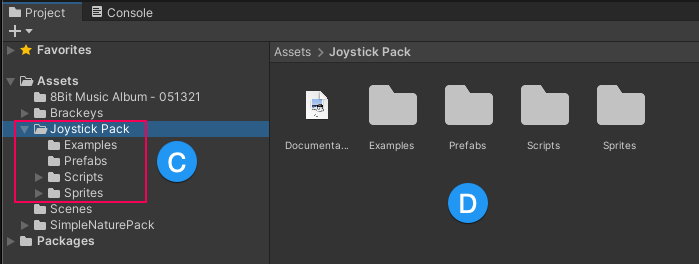Remove imported assets from a project
When you import an asset packageA collection of files and data from Unity projects, or elements of projects, which are compressed and stored in one file, similar to Zip files, with the .unitypackage extension. Asset packages are a handy way of sharing and re-using Unity projects and collections of assets. More info
See in Glossary from the Asset StoreA growing library of free and commercial assets created by Unity and members of the community. Offers a wide variety of assets, from textures, models and animations to whole project examples, tutorials and Editor extensions. Glossary from the Asset StoreA growing library of free and commercial assets created by Unity and members of the community. Offers a wide variety of assets, from textures, models and animations to whole project examples, tutorials and Editor extensions. More info
See in Glossary, the Unity Package Manager places the package’s assets in the Assets directory in your project.
You can manually remove assets from a project if you know the assets aren’t in use. You might consider this action to unclutter your project directory or to free up space on your local hard drive.
Warning: Make sure your project isn’t using any of the assets you remove. Unlike installed packages, the Package Manager doesn’t track imported packages, so it can’t detect when you remove dependent assets.
Before you begin
Make sure you understand these important notes before you begin:
Use this procedure to remove assets only if they came from an asset package and you imported them by following the Download and import an asset package procedure or by importing a custom package. Don’t use this procedure to attempt to remove UPM packagesA Package managed by the Unity Package Manager. Refer to Packages.
See in Glossary that you installed from a registry. Installed UPM packages can come from a registry, but they can also come from the Asset Store. For information about removing UPM packages that you installed from a registry, see Remove a UPM package from a project.-
This procedure removes assets from the current project. It doesn’t remove the same assets that might exist in other projects. It also doesn’t remove asset packages from the cache. To completely remove an asset package and its assets from your computer, you must remove them from multiple locations:
- Use the following procedure to remove the assets from each project that uses them.
- Delete this asset package from the cache. See Delete an asset package from the cache.
Procedure
To remove imported assets from your project:
Open your project.
Open the Package Manager window.
Open the Packages menu and select the My Assets context.
-
Select the asset package you want to remove from your project and take note of the package name (A) and the publisher name (B). These names might help you identify the asset directory in a later step.

The My Assets context shows the package name (A) and the publisher name (B) Open the Project windowA window that shows the contents of your
Assetsfolder (Project tab) More info
See in Glossary.Expand the
Assetsdirectory.Locate the subdirectory for the package you identified in the Package Manager window in a previous step.
-
Explore the directory structure that the publisher created (C), confirm it’s the correct package, and identify the assets you want to delete (D). Note: Unity doesn’t impose directory names or structures on publishers, so their assets might not be in an easily identifiable directory. The directory structure might be simple or complex.

The Project window with an assets folder selected (C) and its contents (D) Select the asset or assets you want to delete. Your selection can be a single asset, multiple assets, all assets in a subdirectory, or more.
Right-click the selected items, and select Delete.
Important:
- ScenesA Scene contains the environments and menus of your game. Think of each unique Scene file as a unique level. In each Scene, you place your environments, obstacles, and decorations, essentially designing and building your game in pieces. More info
See in Glossary that depend on deleted assets aren’t reported as errors in the Console windowA Unity Editor window that shows errors, warnings and other messages generated by Unity, or your own scripts. Glossary that depend on deleted assets aren’t reported as errors in the Console windowA Unity Editor window that shows errors, warnings and other messages generated by Unity, or your own scripts. More info
See in Glossary. If you suspect the removal caused issues, import the package again. Refer to Download and import an asset package. - Assets that you remove from your project remain in the My Assets list view. To remove asset packages from My Assets, refer to Delete an asset package from the cache.